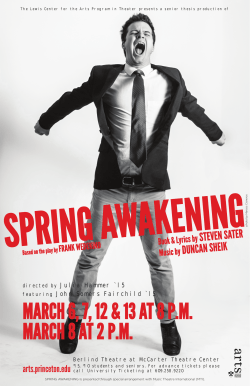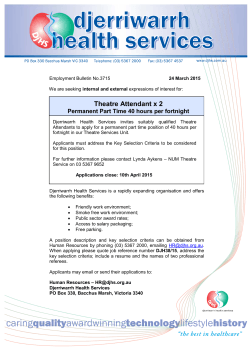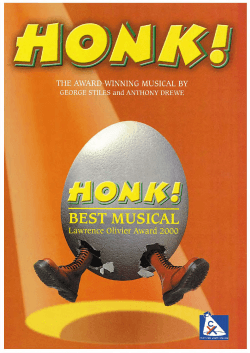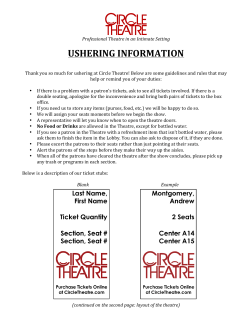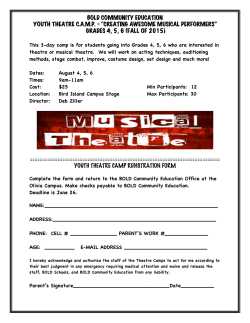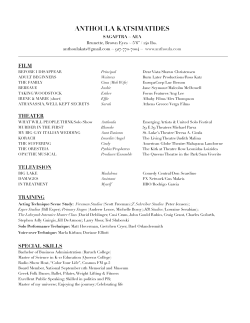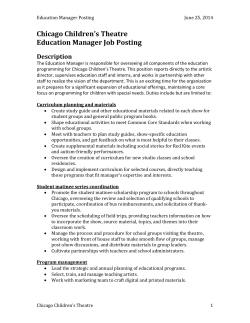
Gordon Square Arts District looks to future after completing $30m
Gordon Square Arts District looks to future after completing $30m capital campaign JACQUELINE BON | THURSDAY, MARCH 26, 2015 BOB PERKOSKI The Gordon Square Arts District is a success story 40 years in the making. At one critical juncture in the neighborhood’s history in the mid 1970's, a massive chunk of the facade of the Gordon Square arcade building actually fell onto the sidewalk. City officials contemplated demolishing the historic structure, but fortunately the Detroit Shoreway Community Development Organization (DCSDO) was formed to help to save it. Today, Gordon Square is a unique arts and retail district at West 65 th and Detroit Avenue within the larger Detroit Shoreway neighborhood. It consists of theatres, restaurants, boutiques, a slew of art galleries and a bookstore. The group has a unique story -- two arts organizations and a CDC led a collaborative campaign over the past decade to remake this block as a pedestrian-friendly arts district. The three organizations involved in GSAD are Cleveland Public Theatre, Near West Theatre and DSCDO, which owns the Capitol Theatre. Leaders here completed the multi-year, $30 million capital campaign in September, then launched directly into the area’s new master plan. The city has 1 committed nearly two million dollars to expand the streetscape that will be available in July 2016. 78th St Studios The revitalization of The Gordon Square Arts District has created over 80 new businesses, including a slew of arts-related enterprises in the 78th Street Studios, which offer one of the largest concentration of arts businesses in the city (and probably within the metropolitan area, as well). Gordon Square also returned four million dollars in sales and property taxes to the local economy last year. “It’s a great story about Cleveland and how we get the bigger picture of what it takes to make change,” says Judi Feniger, executive director of GSAD. “I think the visionaries here could see around the corner and could see what we could be -- and it’s happening now and it’s incredible.” The goals of Gordon Square's new master plan include strengthening and reinforcing the area’s identity; building up the strength, health and livability of the surrounding mixed-income community by capitalizing on assets and bringing in new residents; and focusing on and leveraging the core $30 million dollar investment. Realizing the $30m campaign goal 2 With the campaign complete, more new businesses are popping up in Gordon Square. This past month marked the opening of Graffiti: A Social Kitchen in Battery Park and Local West, a new sandwich shop on Detroit Road. It also saw the opening of oWow, a new independent internet rock station launched at 78th Street Studios. This is a direct result of Gordon Square’s six-year, $30 million joint capitol campaign, which concluded with the opening of Near West Theatre at the end of February. The city of Cleveland funded $5.3 million of the campaign to restore the Capitol Theatre and complete the streetscape, including adding parking spaces, while the remainder was given by individuals, foundations and corporations. Gordon Square Theatre (now Cleveland Public Theatre’s main stage) opened in 1911 as a vaudeville theatre. In 1921, the Capitol Theatre opened. Beginning in the early 70s, the neighborhood started to fade as manufacturing jobs began to leave the area. Much to the dismay of residents, the Capitol Theatre closed in 1985. DSCDO formed in 1973 as the neighborhood began to slip and has been an enduring and powerful force in improving the area. Matt Zone has been the councilman for the Detroit Shoreway neighborhood since 2001. He was 3 born and raised in the neighborhood and has been a key driver behind the area’s revitalization. He believes in the value of nurturing an arts district and views public dollars as the little bit of yeast that raises the private sector. “I have been lobbying for quite some time to expand the streetscape both east and west,” says Zone. “I realized that a lot of the vibrancy of the arts community occurred after receiving public dollars to improve the streetscape.” Zone was born and raised on W. 61st and his father, Michael J. Zone, was a councilman from ‘60 to ‘74. When his father passed away, his mother, Mary J. Zone, finished his term ending in ‘81. “Having been born and raised here I have a great respect and love for this community and I wanted to get in an elected leader position to help with a renaissance in the community,” Zone says. As the neighborhood thrives and gains momentum, the initial $30 million campaign remains the fortifying bones that have initiated change and allowed it to grow as an arts community. New arts-related businesses are adding flesh and blood to those bones. TheCapitol Theatre, a three screen historic movie theatre on W. 65th, was redeveloped right as the 2008 recession hit. The Capitol now has two neighbors, Hausfrau Record Shop and Guide to Kulchur, a bookstore and zine 4 and small press co-op, respectively. Guide to Kulcher was founded by R.A. Washington and Lyz Bly, two fixtures on the arts and culture scene for many years. Washington, who goes by Rafiq, is a DIY artist and curator of one of the last independent bookstores in the city of Cleveland. Guide to Kulchur's readings and events offer free access to culture in a diverse environment. “In terms of us being here, I think people respect how humbly we do things,” says Washington. “People want a bookstore in their neighborhood and it’s an especially good resource for young people who can’t get into bars or don’t have money to spend at restaurants.” Looking forward to the new master plan It’s a shorter walk from Happy Dog at West 58th and Detroit to Rising Star at West 29th and Detroit than from the Terminal Tower to Browns Stadium, yet most people probably don’t realize it. Gordon Square’s master plan aims to improve that connectivity and extend the neighborhood’s urban fabric to Ohio City, including the Hingetown district. The key, arts district leaders say, is to fill in the gaps and link the districts to each other and downtown with new development and community improvement projects. “They say it takes a village and it’s true,” says Feniger. The plan aims to foster stronger communities by filling in missing teeth (unused property) along Detroit and gradually building on underutilized property surrounding The Harp at 45th Street. The new Mariner's Watch apartments at West 32nd and Detroit, which open later this year, offer one example of infill development. The planning committee worked collaboratively to create a strategic plan for the district, taking into consideration a long-term future for the neighborhood that will still fit even 50 or 60 years down the line. “Our goal in going forward with the master plan was to ask ‘Where is the need’ and ‘where is the opportunity?’” says Feniger. "A lot was accomplished and there is a lot to be done. The master plan hopes to embrace the changes created by the capital campaign to imagine a Gordon Square that is fully connected to its surrounding neighborhoods.” The plan aims to foster greater connectivity to the lakefront, improve physical linkages to other neighborhoods and leverage the arts to improve the neighborhood. One idea is to make sure there’s space for galleries, pop-up and outdoor spaces for theatre and public installations. “It’s all part of the idea that people need art and culture -- art visibility is good economically and for everyone’s souls,” Feniger says. 5 Sean Watterson of the Happy Dog at the east side location Sean Watterson, co-owner of Happy Dog, is a huge proponent of the area. “We see Detroit from 25th to 78th Street Studios as an arts corridor where our art is being made as a complement to University Circle,” he told City Council last year. Lakefront access could be improved in a number of ways. The Metroparks has already vastly improved the quality of Edgewater Park. Leaders hope to make additional improvements to the pedestrian tunnel at 65th that links the neighborhood to Edgewater, creating an even more iconic, safe and welcoming passage. They also hope to redevelop 45th and Detroit as a key site because it's highly accessible and a gateway to the neighborhood. Planners have envisioned a retail and housing site, including a possible grocery store, where the current Max Hayes campus is located. (The school will be relocated when the new building is complete next year.) The surrounding property could also be redeveloped. A community vision beyond the capital campaign 6 Housing Court Judge Raymond Pianka has lived in the Detroit Shoreway neighborhood his whole life. He served as DCSDO’s executive director from 1974-1986 and then joined city council from 1986-1996. He has witnessed the long term grassroots effort to save the neighborhood and watched it shift into using the arts district as a positive form of development. “For the arts district, saving that building was the seminal piece,” says Pianka. “It became an epic story about the small community development organization taking on a huge project and it laid the foundation for great success.” The nucleus of arts-related businesses in Gordon Square were created organically without a large developer coming into the neighborhood. The community started off as a hub for live theatre in the 1980’s and has built off the base that it created at that time. It is currently home to Cleveland Public Theatre, Near West Theatre, Blank Canvas Theatre and Talespinner Childrens Theatre, in addition to the Capitol. “One thing going forward is that it will be a collaboration,” says Jenny Spencer, managing director of DSCDO. Spencer is referring not only to collaboration between the arts organizations and DSCDO but an ongoing collaboration with residents. Community outreach for the master plan included putting together a dynamic committee that consisted of many local merchants and community members, interviewing 24 different stakeholders, and hearing ideas from residents. One of DSCDO’s core values is maintaining a mixed income neighborhood with access to resources for all members of the community. DSCDO owns 12 buildings with a total of 210 units, most of which are affordable. Cleveland Public Theatre also engages the community through public outreach programs, including Brick City Theatre, the Student Theatre Enrichment Program (STEP) and Y-Haven Theatre Project. Brick City is CPT’s year-round after-school program and intensive summer arts program for kids ages 5-14 who reside in public housing. STEP is an eight-week arts-based job training program for teens ages 14-19 from low-income families that teaches performance, play creation, writing and production. The program has been running for 20 years and has become a much-admired model for engaging marginalized youth. These community outreach efforts will continue. “There are many parts of our neighborhood that got hit hard by the foreclosure crisis,” says Spencer. “We still have around 30 percent poverty. There are many opportunities to connect people to resources and make meaningful physical development in our community.” 7 8
© Copyright 2025
